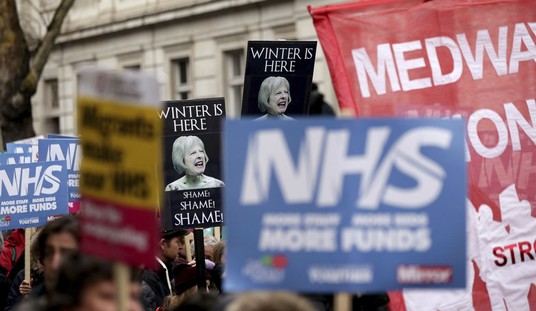Wonder what Barack Obama’s much-heralded — and much-delayed — jobs plan will look like? According to Bloomberg, it’s going to look a lot like all of Obama’s previous job-creation plans. Long on gimmicks and short on the long-term approach, its only virtue appears to be that Obama can’t spend as much money on it:
The ideas President Barack Obama is considering for his new jobs agenda could put hundreds of thousands of people back to work, and still have a limited impact in an economy that remains 6.8 million jobs behind its pre-recession peak, economists said.
Among the options Obama is considering is a version of a tax credit for new hires that could spur the creation of 900,000 additional jobs at a cost of $30 billion, according to an estimate by Michael Greenstone, an economics professor at the Massachusetts Institute of Technology and former chief economist for Obama’s Council of Economic Advisers.
“It allows the private sector to lead the economy toward the areas where the payoffs are greatest,” Greenstone said. …
The White House is considering more infrastructure spending, tax incentives to spur hiring, a reduction in the employer portion of the payroll tax credit and changes to unemployment insurance to subsidize worker retraining for inclusion in a jobs plan Obama is to announce next week, said a person familiar with the discussions.
Tax credits for new hires? Even at the subsidy rate contemplated here, if applied directly, businesses would gain a $33,333 tax credit once for hiring someone, and the benefit will almost certainly be nowhere near that level. Previous proposals have put the credit level on a sliding scale, with a maximum closer to $6,000 for jobs paying $100,000 or more. That doesn’t give businesses any reason to expand staff on its own. A job represents an investment in which businesses expect to serve additional demand that will more than pay for the labor cost involved. A $6000 one-time tax credit — or even a $33,000 credit — won’t compensate a business for the hiring costs, the overhead, and the risk of even hiring a person for a new $50,000-per-year job.
Will businesses take advantage of this tax credit? You bet — for new hires they would have made anyway. In early 2010, CNN reported on an almost identical Jimmy Carter program when the Democrats in Congress floated the same notion:
The ghost of Jimmy Carter’s one-term presidency is hovering over President Obama as the Democrats try to pass a jobs bill in time for this year’s elections. So why is the centerpiece of the measure — a tax break for companies that make new hires — a play straight from Carter’s economic policy circa 1977? …
Critics of Carter’s plan — and Congress’ now — say that the problem with any jobs credit is the potential for waste. It’s estimated that of the companies that claimed the tax credit under Carter’s plan, two-thirds would have hired those employees regardless of the tax break.
“It’s a windfall for companies that want to expand anyway,” says Rea Hederman, a senior policy analyst at the Heritage Foundation. Should the bill pass, Hederman says the big beneficiaries of the tax credit this time around would be companies in the big-growth areas of health care and education.
Another problem with the 1977-78 effort is that many companies, especially small businesses, didn’t even know about the tax credit. A survey by the National Federation of Independent Business found that only 43% of their members knew of the law in January 1978.
Meanwhile bigger companies were, and still are, better-equipped to take advantage of the tax breaks because their armies of accountants can keep up with the complex changes. (Never mind that the law behind the 1970s tax credit was called the Tax Reduction and Simplification Act.)
So this will be just like Cash for Clunkers and the homebuyer tax credits Obama pushed in the first year of his presidency. All it will do will be to subsidize transactions that would have taken place anyway with money borrowed from China and other creditors and end up producing no real economic growth on its own.
As for infrastructure spending, we’ve seen that before in this presidency. Porkulus in 2009 accelerated public-works projects that were supposedly “shovel ready” as a means to stimulate the economy. Two years later, the public-works projects are complete, and the economic growth never arrived. Why? Because American economic growth does not come from rebuilding highways and replacing sidewalks. It comes from investment, innovation, and economic freedom — all areas targeted and damaged by Obama’s regulatory assault on the private sector.
Republicans have a plan that actually addresses the problem:
House Majority Leader Eric Cantor (R-Va.) on Monday laid out an ambitious anti-tax and anti-regulations agenda for the fall.
In a memo to rank-and-file Republicans, Cantor said the House will target 10 major regulations for elimination, and will also seek to enact one major tax cut for businesses.
Republicans are offering the agenda as a contrast to President Obama’s jobs plan, which is set for formal announcement next week and is expected to include stimulus spending.
“I think the administration has … already demonstrated that it is not interested in focusing on private sector growth,” Cantor said after announcing the plan on Fox News. “What our list demonstrates is: Washington now has gotten in the way, and we’ve got to make it easier, finally, for small business people to grow.”
Obama should take a page from the GOP — but he won’t. And as a result, we’ll get the same stagnation that we’ve seen from 2009-present all the way through 2013.








Join the conversation as a VIP Member